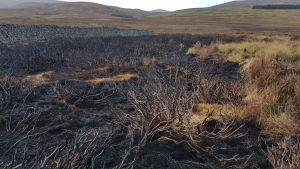Clifton Bain, Direction of the IUCN UK Peatland Programme has been asked to write a blog for the Scottish Forum on Natural Captial, which we've shared here:
The environmental case for protecting our peatlands has long been a strong one, with commitments under international agreements on biodiversity, climate change and water all demanding action to protect peatlands. However, economic forces have often worked in the opposite direction. Over the last century, land managers were given government signals through extensive grant funding that peatlands were wastelands to be exploited or converted to something else in an often failed attempt to make profit. As a result we are left with a legacy of over 80% of our peatlands in a damaged state.
Now we understand that healthy functioning peatlands are a key part of our natural capital worth £billions in terms of the services they provide for biodiversity, water regulation and carbon storage. More alarming is the recognition that if we don’t repair our peatlands there is an even greater long term cost to society resulting from the loss of carbon to the atmosphere and the impacts on flooding and drinking water supplies. Scotland’s First Minister Nicola Sturgeon speaking at the World Forum on Natural Capital in Edinburgh summed it up perfectly by describing spending on peatland restoration as one of the best investments we can make as a society.
The importance of peatlands as a key part of our natural capital was reinforced at the recent UN Conference on Climate Change in Paris where the agreement recognised that to keep below 2 degrees global warming we need to take serious steps to finance the protection of our natural carbon stocks and prevent emissions from habitat degradation. During the talks in Paris the Scottish Environment Minister Aileen McLeod highlighted the Scottish Government’s commitment to peatland restoration, with £8 million spent since 2013 and over 8,000ha restored under the successful Scottish Natural Heritage Peatland ACTION grant. Peatlands have also been included as a priority for action in the draft Scottish budget for 2016-17 and taking this forward will be the new group established under Scotland’s National Peatland Plan.
With an estimated 600,000ha of restorable peatland in Scotland there is a clear need for accelerated effort and one of the ways of achieving this is for greater private investment alongside government funds. In this enlightened era for peatlands we have to not only meet the costs of restoring our peatlands but also ensure that land managers see ongoing benefit in maintaining our peatlands in a healthy state. This is one of the driving forces behind the development of a Peatland Code, which will facilitate public/private funding for peatland restoration and management.
 The Peatland Code was launched at the World Forum on Natural Capital with Mark Wilson, Marketing Manager of global carpet manufacturing company, Interface, describing how he was blown away by the valuable role our peatlands play and how he saw business as having a responsibility to be ahead of the curve in taking action to protect our natural capital.
The Peatland Code was launched at the World Forum on Natural Capital with Mark Wilson, Marketing Manager of global carpet manufacturing company, Interface, describing how he was blown away by the valuable role our peatlands play and how he saw business as having a responsibility to be ahead of the curve in taking action to protect our natural capital.
The Code is important in providing a quality standard giving confidence to funders of peatland restoration and allowing the carbon and other benefits to be quantified according to recognised scientific methods. For land managers the Code provides a means for ongoing income alongside government grants aimed at supporting healthy peatlands. With most of our peatlands in remote rural areas the benefits of even a modest injection of funds can have significant impact on vulnerable rural communities and ensures a better quality environment to live and work in.
The Code is not an offset mechanism due to policy in this area still evolving but instead it is aimed at those companies who recognise that supporting natural capital should be a core part of the business. The Code is also aimed at businesses whose brand benefit from a healthy Scottish countryside and those who can make costs savings such as the water industry. Peatlands are an exciting prospect for investors looking to secure environmental impact and there is a growing portfolio of ‘shovel ready’ projects across non-governmental organisations, public land, community groups and private estates that make a viable proposition.
One of the interesting issues to come out of the World Forum on Natural Capital is the wide range of financial mechanisms that could help support the protection and recovery of our environment. Work on the Peatland Code will include investigation into potential funding sources and drawing on the skills of the private investment and financial services sector. Investing in peatlands makes clear environmental and economic sense and we are now at the start of an exciting journey to ensure this translates into public and private funds being made available now, to avoid the astronomical costs our damaged peatlands would impose on future generations.
Clifton Bain leads the 'Natural Capital and Scotland's Peatlands' Project Group of the Scottish Forum on Natural Capital. If you are interested in being involved in the Project Group please contact Mike Elm, Project Officer on 0131 312 4765 or email melm@naturalcapitalforum.com.
Read more about the Peatland Code: 'Protect the peat and conserve the carbon', an article in Environmental Finance magazine.










